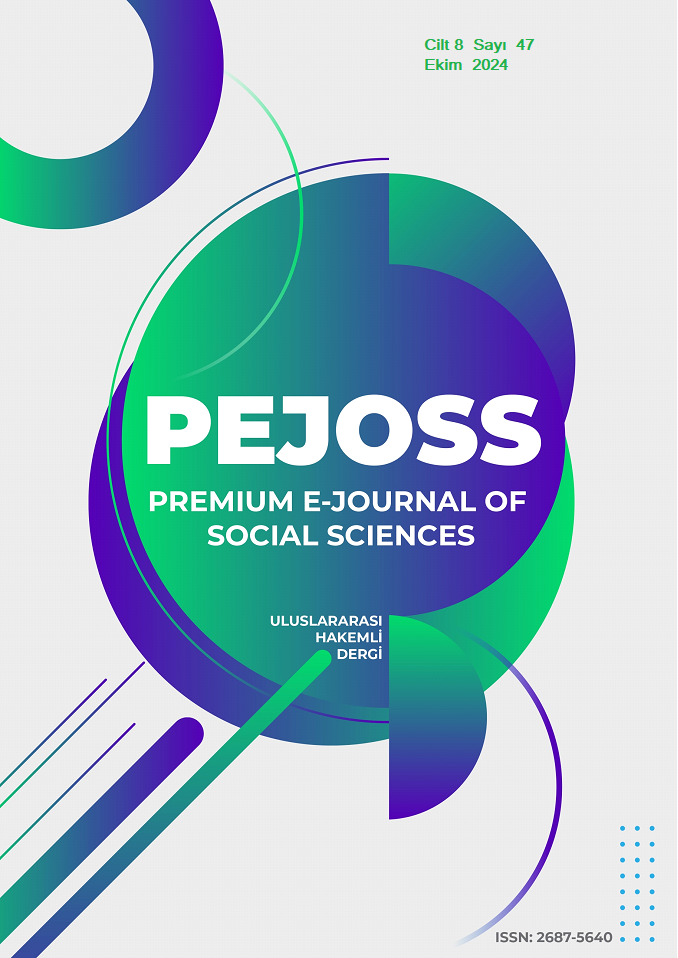“İpek Yolu” ve Sanatın Kültürleşmesi: Azerbaycan Ekseninden Bir İnceleme
DOI:
https://doi.org/10.5281/zenodo.14020747Anahtar Kelimeler:
İpek Yolu, Azerbaycan, kültürel ilişkiler, müzik kültürleri, festivalÖzet
Eski Doğu ülkelerinde “kervan yolları” olarak nitelendirilen yollar üzerinde bulunan ülke ve şehirler, kısa sürede büyük gelirler elde ederek askeri, siyasi ve ekonomik açıdan gelişmişlerdir. Kültürel başarıların ülkeler arasında entegrasyonunda İpek Yolu’nun önemi Azerbaycan'ı her zaman ilgilendiren öncelikli konulardan biridir. Bu makale, İpek Yolu’nun Azerbaycan üzerindeki kültürel ve sanatsal etkilerini ele almayı amaçlamaktadır.
Bu çalışma İpek Yolu’nun kültürel unsurların yayılmasına olan katkısını araştırmak, sanat, dil ve geleneklerin nasıl yayıldığını anlamaya yardımcı olabilmek, farklı kültürler arasındaki etkileşimlerin dinamiklerini incelemek, kültürel alışverişlerin ve sentezlerin nasıl gerçekleştiğini ortaya koyabilmek açısından önemlidir.
Kuramsal çerçeveyi oluşturma adına çalışmada literatür taraması yapılmış, “İpek yolu” festivallerine dair bilgiler araştırılmış, doküman incelemesi tekniğe uygun olarak gerçekleştirilmiş, araştırmaya tabi tutulan konu hakkında diğer araştırmacılar tarafından üretilen yayınların belli bir kısmı göz önünde bulundurulmuştur.
Makalede, sanat örneklerini ve kültürel kazanımlarını uzak ülkelere taşıyan İpek Yolu üzerinde yer alan ülkelerde yaşamış önemli hükümdarların ve tanınmış şahsiyetlerin insanlık tarihine büyük şahsiyetler olarak girdiğine değinilmektedir. İpek Yolu, tarih boyunca ticari malların yanı sıra kültürel değerlerin de taşındığı bir yol olmuşdur. Azerbaycan, İpek Yolu’nun merkezi konumlarından biri olarak sanatın kültürleşmesinde önemli bir rol oynamıştır.
Ülkeler arasındaki kültürel kazanımların buluşması ve entegrasyonunda tarihi İpek Yolu’nun önemi Azerbaycan'da sürekli güncelliğini koruyan öncelikli konulardan biridir. Bu bakımdan Şeki'de düzenlenen “İpek Yolu” festivali dünyanın farklı ülkelerinden müzisyenlerin katılımıyla en ilgi çekici ve güncel etkinlik olarak kültür tarihine geçmiştir.
Sonuç olarak “İpek Yolu” aracılığıyla sanat, teknoloji ve bilim gibi kültürel unsurlar hızla yayıldığı ve bu medeniyetler arasında zengin bir kültürel alışverişin gerçekleşmesini sağladığı görülmektedir. Farklı kültürlerin buluştuğu bu yollarda, sanat ve mimaride önemli etkiler görüldü. İpek Yolu üzerindeki şehirler, farklı sanat akımları ve mimari stiller arasında bir köprü işlevi gördü. Bu, yerel sanat ve mimarinin zenginleşmesine ve çeşitlenmesine yol açtı. İpek Yolu'nun sunduğu kültürel alışveriş, gelenek ve göreneklerin zenginleşmesini sağladı. Farklı kültürel etkiler, yerel geleneklerde ve festivallerde kendini gösterdi. Bu etkileşim, kültürel çeşitliliği artırdı ve geleneklerin evrimini etkiledi.
İndirmeler
Referanslar
Alekperova, A. (2001). Nahçıvan Özerk Cumhuriyyeti müzik kültürünün gelişim aşamaları. Ecemi Yayınları.
Aliyeva, Z. (2019). Enlightenment Movement in Azerbaijane. Postmodernism Problems, 9(3), 429-439.
Asadova, S. (2022). Events Taking Place in the Socio-Political and Literary-Cultural Environment of Azerbaijan. Scientific Collection InterConf, 115, 137-140.
Baku Jazz Festival: Euronews link (euronews) https://www.euronews.com/culture/2023/10/30/baku-jazz-festival-rhythm-and-art-captivate-azerbaijans-capital
Boulnois, L. (2004). Silk Road: Monks, Warriors & Merchants on the Silk Road. Hong Kong: Odyssey Publications.
Christian, D. (2000). Silk roads or steppe roads? The Silk Roads in world history. Journal of World History, 11(1), 1-26. https://www.jstor.org/stable/20078816
“Çello sanatçısı Yo-Yo Ma'nın “İpek Yolu””projesinin on yılı. https://www.kontinent.org/article.php? aid=49cd64143e842
Gabala International Music Festival: https://en.wikipedia.org/wiki/Gabala_International_Music_Festival
Halk masalları. (1961). Azerbaycan Devlet Yayınevi, Bakü.
Hasanzade, K. (2022). A look at the history and musical culture of the peoples living in the territory of Azerbaijan. Journal for the Interdisciplinary Art and Education, 3(3). 97-105.
Li, M. (2020). A Musical Journey Along the Silk Road—Encounter, Discovery and Change. In China and the New Silk Road. Springer. https://doi.org/10.1007/978-3-030-43399-4_14
Seferova, Z. (2020). Azerbaycan müzik tarihi. Cilt V. Bakü: Elm Yayınları.
Seyidbeyli, M. (2021). Azerbaijan on the Great Silk Road between China and Europe (Historical Survey). Global Journal of Human-Social Science. 21(D2). https://gjhss.com/index.php/gjhss/article/view/ 1507
Tokaç, M.S. (2018). XIX. Yüzyıla kadar Osmanlı Dönemi Kent Müziğine, Nazariyat Ve Bestecilik Yönündeki Gelişmelere Genel Bir Bakış. Uluslararası Müzik ve Sahne Sanatları Dergisi. 2 (80). 80-91.
Unesco. (2023, July 3). UNESCO and Azerbaijan to promote the shared legacy of the Silk Roads. https://www.unesco.org
İndir
Yayınlanmış
Nasıl Atıf Yapılır
Sayı
Bölüm
Lisans
Telif Hakkı (c) 2024 Premium e-Journal of Social Sciences (PEJOSS)

Bu çalışma Creative Commons Attribution 4.0 International License ile lisanslanmıştır.


